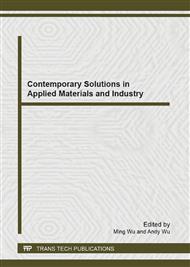[1]
S.G. Lee, Y. -S. Ma, G.L. Thimm, J. Verstraeten, Product lifecycle management in aviation maintenance, repair and overhaul, Computers in Industry 59 (2008) 296-303.
DOI: 10.1016/j.compind.2007.06.022
Google Scholar
[2]
Liu Ming, Zuo Hongfu, Geng Duanyang, Cai Jing, Expert system of maintenance review board report based on CBR and RBR, Journal of Beijing University of Aeronautics and Astronautics 5 (2006) 521-525.
Google Scholar
[3]
Yu Fengjie, Ke Yinglin, Ying Zheng, Decision on failure maintenance for aircraft automatic join-assembly system, Computer Integrated Manufacturing Systems 15 (9) (2009) 1823-1830.
Google Scholar
[4]
Johannes Christian, Horst Krieger, Andreas Holzinger, Reinhold Behringer, Virtual and Mixed Reality Interfaces for e-Training: Examples of Applications in Light Aircraft Maintenance, in: Proceedings of the 4th international conference on Universal access in human-computer interaction: applications and services (UAHCI 2007), 2007, p.520.
DOI: 10.1007/978-3-540-73283-9_58
Google Scholar
[5]
Sajay Sadasivan, Deepak Vembar, Carl Washburn, Anand K. Gramopadhye, Evaluation of Interaction Devices for Projector Based Virtual Reality Aircraft Inspection Training Environments, in: Proceedings of the 2nd international conference on Virtual reality (ICVR 2007), 2007, p.533.
DOI: 10.1007/978-3-540-73335-5_58
Google Scholar
[6]
Lu Zhong, Sun Yongchao, Disassembly sequence planning of civil aircraft products for maintainability design, Acta Aeronautica Et Astronautica Sinica 31 (1) (2010) 143-150.
Google Scholar
[7]
Shu Li, Liu Yi, Liu Jia, Nandong Wang, The application research on the virtual maintenance in aircraft design, in: Reliability, The 8th International Conference on Reliability, Maintainability & Safety (ICRMS 2009), 2009, p.678–683.
DOI: 10.1109/icrms.2009.5270103
Google Scholar
[8]
Christiand, Jungwon Yoon, Optimal assembly path planning algorithm for aircraft part maintenance, in: International Conference on Control, Automation and Systems (ICCAS 2007), 2007, pp.2190-2194.
DOI: 10.1109/iccas.2007.4406696
Google Scholar
[9]
Hao Xu, Pu Wan, An improved genetic algorithm for solving simulation optimization problems, International Journal of the Physical Sciences 6 (10) (2011) 2399-2404.
Google Scholar
[10]
LIU Jian-hua, NING Ru-xin, WAN Bi-le, XIONG Zhen-qi, Research of complex product assembly path planning in virtual assembly, Journal of System Simulation 19 (9) (2007) 2003-(2007).
Google Scholar
[11]
Lian Ding, Alex Ball, Jason Matthews, Chris McMahon, Manjula Patel, Product representation in lightweight formats for product lifecycle management (PLM), in: 4th International Conference on Digital Enterprise Technology (DET 2007), (2007).
Google Scholar
[12]
Lian Ding, Dannie Davies, Christopher A. McMahon, The integration of lightweight representation and annotation for collaborative design representation, Research in Engineering Design 19 (4) (2009) 223-238.
DOI: 10.1007/s00163-008-0052-3
Google Scholar


